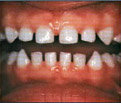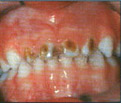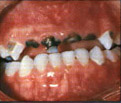Developmental Events:
Interaction with Dentist:
Home Oral Hygiene Routine:
It is very important to maintain the health of the primary teeth. Neglected cavities can and frequently do lead to problems which affect developing permanent teeth. Primary teeth or baby-teeth are important for (1) proper chewing and eating, (2) providing space for the permanent teeth and guiding them into the correct position, and (3) permitting normal development of the jaw bones and muscles. Primary teeth also affect the development of speech and add to an attractive appearance. While the front 4 teeth last until 6-7 years of age, the back teeth (cuspids and molars) aren’t replaced until age 10-13.



One serious form of decay among young children is baby bottle tooth decay. This condition is caused by frequent and long exposures of an infant’s teeth to liquids that contain sugar. Among these liquids are milk (including breast milk), formula, fruit juice and other sweetened drinks.
Putting a baby to bed for a nap or at night with a bottle other than water can cause serious and rapid tooth decay. Sweet liquid pools around the child’s teeth giving plaque bacteria an opportunity to produce acids that attack tooth enamel. If you must give the baby a bottle as a comforter at bedtime, it should contain only water. If your child won’t fall asleep without the bottle and its usual beverage, gradually dilute the bottle’s contents with water over a period of two to three weeks.
After each feeding, wipe the baby’s gums and teeth with a damp washcloth or gauze pad to remove plaque. The easiest way to do this is to sit down, place the child’s head in your lap or lay the child on a dressing table or the floor. Whatever position you use, be sure you can see into the child’s mouth easily.
Sucking is a natural reflex and infants and young children may use thumbs, fingers, pacifiers and other objects on which to suck. It may make them feel secure and happy or provide a sense of security at difficult periods. Since thumb sucking is relaxing, it may induce sleep.
Thumb sucking that persists beyond the eruption of the permanent teeth can cause problems with the proper growth of the mouth and tooth alignment. How intensely a child sucks on fingers or thumbs will determine whether or not dental problems may result. Children who rest their thumbs passively in their mouths are less likely to have difficulty than those who vigorously suck their thumbs.
Children should cease thumb sucking by the time their permanent front teeth are ready to erupt. Usually, children stop between the ages of two and four. Peer pressure causes many school-aged children to stop.
Pacifiers are no substitute for thumb sucking. They can affect the teeth essentially the same way as sucking fingers and thumbs. However, use of the pacifier can be controlled and modified more easily than the thumb or finger habit. If you have concerns about thumb sucking or use of a pacifier, consult your pediatric dentist.
A few suggestions to help your child get through thumb sucking:
 Harold’s Hideaway Thumb by Harriet Sonnenschein, Jurg Obnzt (Illustrator), Jurg Obrist (Illustrator)
Harold’s Hideaway Thumb by Harriet Sonnenschein, Jurg Obnzt (Illustrator), Jurg Obrist (Illustrator)
 David Decides About Thumbsucking – A Story for Children, a Guide for Parents by Susan Heitler P H.D., Paula Singer (Photographer)
David Decides About Thumbsucking – A Story for Children, a Guide for Parents by Susan Heitler P H.D., Paula Singer (Photographer)
It’s never too early to keep an eye on your child’s oral development. Your pediatric dentist can identify malocclusion — crowded or crooked teeth or bite problems — and actively intervene to guide the teeth as they emerge in the mouth. Orthodontic treatment early can prevent more extensive treatment later.
Malocclusion is often inherited. Orthodontic problems also are caused by dental injuries, the early loss of primary teeth or such habits a thumb sucking, fingernail biting, or lip biting. Your pediatric dentist can help your child avoid oral habits that may create orthodontic problems.
Early orthodontics can enhance your child’s smile, but the benefits far surpass appearance. Pediatric orthodontics can straighten crooked teeth, guide erupting teeth into position, correct bite problems, even prevent the need for tooth extractions. Straight teeth are easier to keep clean and less susceptible to tooth decay and gum disease.
Different orthodontic appliances work in different ways to benefit your child’s dental health. Some are fixed; others are removable. Your pediatric dentist will explain which appliance is best for your child, what the treatment can do, and how long it will take.
As with any dental treatment, the more a child cooperates, the better the results. First, careful brushing and flossing keep the appliance and your child’s health in top shape. (Removable appliances should be brushed each time the teeth are brushed.) Second, regular dental check-ups — besides orthodontic appointments — protect your child from tooth decay and gum disease. Third, prompt contact with your pediatric dentist when an appliance breaks will keep orthodontic treatment on-time and on-track.
Your child can eat a normal diet except sticky foods (gum, caramels) and large, hard foods (peanuts, ice chips, popcorn). Some appliances alter speech, but most children adapt quickly and speak clearly within a day or two. Generally, children can safely run, jump, swim, and play with an orthodontic appliance. Check with your pediatric dentist for specific advise on your child’s activities.
Begin daily brushing as soon as the child’s first tooth erupts. A pea-size amount of fluoride toothpaste can be used after the child is old enough not to swallow it. By age 4 or 5, children should be able to brush their own teeth twice a day with supervision until about age seven to make sure they are doing a thorough job. However, each child is different. Your dentist can help you determine whether the child has the skill level to brush properly.
Proper brushing removes plaque from the inner, outer and chewing surfaces. When teaching children to brush, place toothbrush at a 45 degree angle; start along gum line with a soft bristle brush in a gentle circular motion. Brush the outer surfaces of each tooth, upper and lower. Repeat the same method on the inside surfaces and chewing surfaces of all the teeth. Finish by brushing the tongue to help freshen breath and remove bacteria.
Flossing removes plaque between the teeth where a toothbrush can’t reach. Flossing should begin when any two teeth touch. You may wish to floss the child’s teeth until he or she can do it alone. Use about 18 inches of floss, winding most of it around the middle fingers of both hands. Hold the floss lightly between the thumbs and forefingers. Use a gentle, back-and-forth motion to guide the floss between the teeth. Curve the floss into a C-shape and slide it into the space between the gum and tooth until you feel resistance. Gently scrape the floss against the side of the tooth. Repeat this procedure on each tooth. Don’t forget the backs of the last four teeth.
Tooth brushing is one of the most important tasks for good oral health. Many toothpastes, and/or tooth polishes, however, can damage young smiles. They contain harsh abrasives which can wear away young tooth enamel. When looking for a toothpaste for your child make sure to pick one that is recommended by the American Dental Association. These toothpastes have undergone testing to insure they are safe to use.
Remember, children should spit out toothpaste after brushing to avoid getting too much fluoride. If too much fluoride is ingested, a condition known as fluorosis can occur. If your child is too young or unable to spit out toothpaste, consider providing them with a fluoride free toothpaste, using no toothpaste, or using only a “pea size” amount of toothpaste.